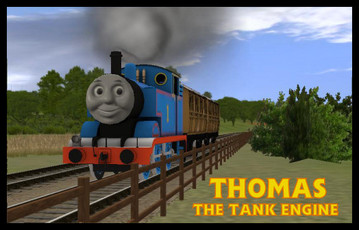

#THOMAS SODOR ISLAND 3D SERIES#
One of the more famous settlements on Sodor is Ffarquhar, the terminus of Thomas the Tank Engine's Branch Line.Īll of the other settlements on the island are described in Locations on the Island of Sodor, while the six railway lines from The Railway Series are described below. The capital and administrative centre of Sodor is the city of Suddery however, Tidmouth has grown to be the largest town on the island. The summit is reached by the Culdee Fell Railway, which is based on the Snowdon Mountain Railway in Wales. Its highest mountain is Culdee Fell, which was modelled on Snowdon: the ridge of Devil's Back copies the Clogwyn ridge on Snowdon. The place names on Sodor are mostly a mixture of Manx and Norse. Its north-east edge overrides and replaces the real Walney Island. Its north-west coast is separated from the Isle of Man by a sea strait called the Sudrian Sea (Faarkey-y-Sudragh), four miles (6 km) wide. The island is roughly diamond-shaped, 62 miles (100 km) wide east to west and 51 miles (82 km) long north to south. Sodor is usually shown as much larger than the Isle of Man. The Island of Sodor has its own flag, which consists of a blue-white-blue triband with yellow fimbriations. īelow are some words and phrases, and place-names translated into English: The names of some of the 'historical' characters – used in the background but not appearing in the stories – were taken from locations on the Isle of Man, such as Sir Crosby Marown ( Crosby is a village in the parish of Marown) and Harold Regaby (Regaby is a tiny hamlet on the parish boundary between Andreas and Bride). Killdane, which comes from "Keeill-y-Deighan" (Church of the Devil), hills are called Knock and Cronk, while "Nagh Beurla", means "I speak no English", a distortion of the Manx. Some of the locations have quasi-Manx names, e.g.

Ī lot of the place names on Sodor are clearly based on Manx forms, but often the nouns are inverted to match English word order. The fictional native language of Sodor is "Sudric", a language similar to Manx. "Everybody knew that there was an Isle of Man, but we decided to 'discover' another island – the Island of Sodor – and so give the poor deprived Bishop the other half of his diocese!" (Rev. W. Awdry) Hence Awdry sited Sodor in the Irish Sea, between the Isle of Man and Barrow-in-Furness in Lancashire (Barrow later became part of the new county of Cumbria during the 1974 re-organisation). Thus there is no island of Sodor rather, the fictional island takes its name from an archipelago.Īwdry was intrigued to find that although the Bishop had the title "Sodor and Man", he had only Man for his diocese. The Sudreys became "Sodor", which was fossilised in the name of the Diocese, long after it ceased to have any authority over the Scottish Islands. Orkney and Shetland (also known as Zetland). "Southern Isles" compared to Norðreyjar ("The Nordreys" ), or the " Northern Isles", i.e. This is because the Isle of Man was part of the Kingdom of Mann and the Isles, which included the Hebrides, known in Old Norse as the Suðreyjar, (anglicised as "The Sudreys" ) i.e. The bishop of the Isle of Man is known as Bishop of "Sodor and Man". Their abridged notes were published in 1987 (until out of print in 1992) in a book entitled The Island of Sodor: Its People, History and Railways. By the time they had finished, they knew more about Sodor than would ever be used in The Railway Series stories. Some place names were Sudric equivalents or near-equivalents of those in the real world (for instance, Skarloey was a rough Sudric equivalent of the Welsh Talyllyn: logh (Manx) = llyn (Welsh) = "lake"). Elsbridge was named after Wilbert's parish of Elsworth in Cambridgeshire. A large island would meet the criteria he required, giving him the isolation from changes to the British railway system while giving him somewhere that people could easily imagine.īetween them, Awdry and his younger brother George worked out Sodor's history, geography, industry and language ("Sudric"). Awdry noted that while there was an Isle of Man, there was no similar island of Sodor (the name derives from Old Norse Suðreyjar, "southern isles", a term that referred to the Hebrides and islands along the west coast of Scotland). Inspiration came on a visit to the Isle of Man, which forms the Diocese of Sodor and Man in 1950. Awdry required a setting for his books that would be within Great Britain, but would be sufficiently isolated from the rest of British Railways to allow him to do as he wished with the location.

The need for consistency in the locations for The Railway Series necessitated the creation of a suitable location.


 0 kommentar(er)
0 kommentar(er)
